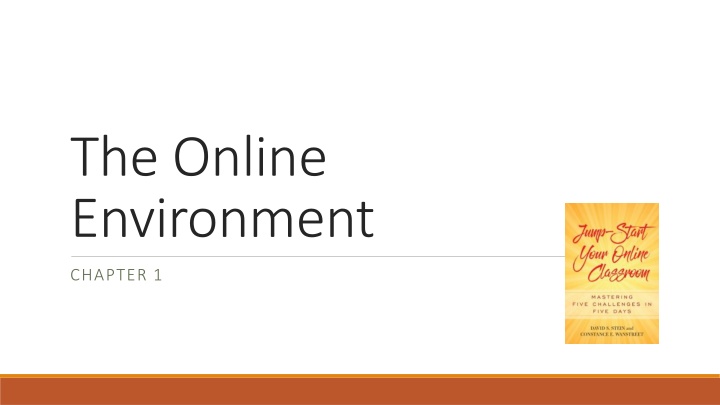The Online Environment
The online environment plays a crucial role in our daily lives, shaping how we interact, learn, and work. Chapter 1 delves into the fundamentals of navigating this digital landscape, providing insights on key concepts and practices essential for thriving in the interconnected world. Discover the dynamics of online interactions, explore tools for effective communication, and unlock the potential of digital platforms to enhance your experiences and opportunities.
Uploaded on Feb 24, 2025 | 1 Views
Download Presentation

Please find below an Image/Link to download the presentation.
The content on the website is provided AS IS for your information and personal use only. It may not be sold, licensed, or shared on other websites without obtaining consent from the author.If you encounter any issues during the download, it is possible that the publisher has removed the file from their server.
You are allowed to download the files provided on this website for personal or commercial use, subject to the condition that they are used lawfully. All files are the property of their respective owners.
The content on the website is provided AS IS for your information and personal use only. It may not be sold, licensed, or shared on other websites without obtaining consent from the author.
E N D
Presentation Transcript
The Online Environment CHAPTER 1
Learning Outcomes 1. Explain social practices that help create an environment for learning 2. Describe tools used to create private and public learning spaces 3. Name ways to help learners feel connected to you and one another 4. Identify ways to foster co-ownership of the teaching and learning process 5. Describe the role of authentic assessments in measuring outcomes
Elements of the Online Environment Social practices help you establish your online persona and create an environment for learning. Use tools to build private areas for learners to record their emerging ideas and shared spaces for learners to negotiate meaning. Give your learners/participants opportunities to feel connected to you and one another. Learning communities provide a powerful context for learning where the members interact with one another in a meaningful way and accept co-ownership of the teaching and learning process. Measure outcomes through authentic assessments and timely, meaningful feedback. Stein & Wanstreet, 2011
Social Practices Social practices help you establish your online persona and create an environment for learning. Involves faculty skill in coaching discussion groups; providing feedback on discussion quality; offering guidance on how to express oneself through text, emoticons, and other nonverbal communication. What faculty say will become less important than what they do to help generate critical thought. How learners form study teams and what the team learned can become more important than any single individual with whom learners study.
Tools Use tools to build private areas for learners to record their emerging ideas and shared spaces for learners to negotiate meaning. The interaction of tools, learners, and the instructor shapes instruction. Tools include any device that mediates or shapes instruction. Examples: synchronous and asynchronous technology, books, online resources, group size, online learning theories, self- concepts In the process of changing, tools change how we teach and learn. Tools can extend learning environments beyond our time and space boundaries.
Participants Give your learners/participants opportunities to feel connected to you and one another. Each participant has a role: Instructors: focus on learning process rather than on imparting content Learners: build knowledge by bringing digital content into the class Experts/Instructional support: provide immediate assistance and resources to aid learning.
Learning Communities Learning communities provide a powerful context for learning where the members interact with one another in a meaningful way and accept co-ownership of the teaching and learning process. Academic communities can facilitate individual and collective learning through skill acquisition: Ability to work in groups with people of various backgrounds Communicate effectively, orally and in writing Combine independent and interdependent work to produce meaningful outcome Use social networking and collaborative software
Outcomes Measure outcomes through authentic assessments and timely, meaningful feedback. Outcomes are the target of the learning activity. Problem space is where activity is directed; for example, problem of changing a traditional course into a Web-based course. Problem is transformed into outcomes with the help of mediating instruments, tools, and signs, such as discussion boards, chat rooms, e-mail, and other technology.
Interaction Creates Meaningful Environment The interaction among tools, participants, social practices, community, and the outcome create an environment for a meaningful online educational experience.
Five Challenges for First-Time Online Instructors 1. Making the transition to online teaching 2. Building online spaces for learning 3. Preparing students for online learning 4. Managing and facilitating the online classroom 5. Assessing learner outcomes in an online classroom
Relating Online Elements to the Five Challenges CHALLENGE STRATEGY 1. Making the transition to online teaching Social practices help you establish your online persona and create an environment for learning. 2. Building online spaces for learning Use tools to build private areas for learners to record their emerging ideas and shared spaces for learners to negotiate meaning. 3. Preparing students for online learning Give your learners opportunities to feel connected to you and one another. 4. Managing and facilitating the online classroom Learning communities provide a powerful context for learning where the members interact with one another in a meaningful way and accept co- ownership of the teaching and learning process. 5. Assessing learner outcomes in an online classroom Measure outcomes through authentic assessments and timely, meaningful feedback.
Chapter 1 References Stein, D. S., & Wanstreet, C. E. (2017). Jump-start your online classroom: Mastering five challenges in five days. Sterling, VA: Stylus Publishing. Stein, D. S., & Wanstreet, C. E. (2011). Teaching in the future: A blueprint for faculty development. In S. D Agustino (Ed.), Adaptation, resistance and access to instructional technologies: Assessing future trends in education (pp. 445 459). Hershey, PA: IGI Global.
Are You Ready to Teach Online? CHAPTER 2
Learning Outcomes 1. Describe ways to overcome the physical separation of instructors and learners online 2. Explore the role of online presence 3. Identify differences in communication processes online versus in person 4. Analyze your competencies as a beginning online instructor
What is e-Teaching? The challenge in e-teaching is to overcome the physical separation of ourselves from our learners because the teaching act and the learning act may be separated in time and space. Teaching in virtual environment means developing relationships with: Learners Content Tools Activities Outcomes
Is e-Teaching Really Different? E-teaching requires instructors to be aware of practice and how tools may change how we teach and learn. How we act in the virtual classroom space is different from face-to-face teaching: Class meets all week long; instructor presence goes beyond a single class meeting. Instructors come to know their learners through their work products; listen to words and see thoughts emerge from dialogue. Instructor is not the sole source of content. Virtual classroom is inclusive, diverse, and welcoming of nontraditional learners. Time zones factor into online synchronous meetings. Communication can be easily misunderstood.
Online Instructor Competencies Competent online instructors deeply understand the practices involved in teaching online and apply skills and knowledge in various electronic teaching situations. Areas of online instructor performance: Interaction Course management Course organization Use of technology Content knowledge Teamwork skills Lee & Hirumi (2004)
Relating Challenges to Competencies LEE & HIRUMI (2004) PERFORMANCE AREAS CHALLENGE 1. Making the transition to online learning 1. Course organization 2. Building online spaces for learning 2. Technology and teamwork 3. Preparing students for online learning 3. Interaction 4. Managing and facilitating the online classroom 4. Course management 5. Assessing learner outcomes 5. Content knowledge
Good Instructional Practice Many online instructor competencies are good practice in face-to-face classrooms. Good instructional practices do not vary according to the site of instruction; however, how instructors adapt and modify practice is influenced by the instructional environment. Learners know us only through the way we use online spaces.
Are You Ready to Teach Online? Points to Remember: 1. The challenge in e-teaching is to overcome the physical separation of ourselves from our students. 2. Online classes meet all week long; your presence goes beyond a single class meeting. 3. Communication processes are more sensitive online and can be easily misunderstood. 4. Show your presence through e-mail, discussion posts, and feedback. 5. Competencies for good online instruction are also good practices for face- to-face instruction. Challenge 1
Chapter 2 References Lee, J- L., & Hirumi, A. (2004). Analysis of essential skills and knowledge for teaching online. Retrieved from ERIC database. (ED485021) Stein, D. S., & Wanstreet, C. E. (2017). Jump-start your online classroom: Mastering five challenges in five days. Sterling, VA: Stylus Publishing.
Addressing Concerns About Teaching Online CHAPTER 3
Learning Outcomes 1. Examine your teaching philosophy and your attitude toward online teaching 2. Explore your online instructional platform for spaces that encourage interaction 3. Reassess how you conceptualize class time 4. Explain the function of a course plan 5. Prepare a course calendar
Philosophy of Online Instruction Address these responsibilities when developing your philosophy: Become skilled in identifying the factors that contribute to success in learning. Be consistent in your approach to teaching and consistently keep up with our fields. Remember that what is taught in the classroom takes time to become real to learners. Remember that learning is a dynamic process that may change daily. Create an environment where learners feel safe and respected. Levine (2007)
Common Concerns About Online Teaching 1. 2. 3. 4. 5. Where is the virtual classroom? How is time different? How is space different? How do I manage the presentation of content? How does my teaching persona change?
Where is the Virtual Classroom? Instruction takes place in an online instructional platform. Different online platforms provide different tools and different degrees of freedom for instructors to implement particular approaches to instruction. Approaches can range from dependent learning to collaborative, interdependent learning. Learn the advantages and limitations of your online instructional platform. In the electronic learning space, time is different; and the spatial arrangements between the learners and the instructor are different.
How Is Time Different? In physical classrooms, the instructor controls the pace of instruction; the teaching and learning acts are conducted in real time. Synchronous teaching is real time, too. Learners, instructors, content, and technology come together in a single place for instruction. E-time does not require that learners and instructors be online at the same time. E-time fits the learner s study rhythms. E-time signals shared control over the time of learning, with the learner having greater control. E-time makes educational opportunities available to adults who may work full time, have family commitments, or have limitations to their mobility.
How is Space Different? Instructors determine how space in the physical classroom is used. Space can be rearranged to accommodate different activities. Nonverbal cues may signal comprehension. Online spaces are available to accomplish different intellectual activities: content pages discussion boards e-mail collaborative workspaces Online spaces change as technology changes. Online instructors see the learning happen through the texts and other artifacts that learners create. Online instructors listen through their eyes, picture the learners, and listen for the rhythm and pacing in text. Learning happens online and offline throughout the week.
How Do I Manage Presentation of Content? Content presentation is a function of: how you believe learning occurs the level of learning required in the course the technologies available the ease of using certain technologies sound learning theory Behaviorist strategies can be used to teach facts. Cognitivist strategies can be used for principles and processes Connectivist strategies can be used with networked, Web-based learning tools. Sources of content include textbook publishers and MERLOT.
Develop a Course Plan Date and Course Goal Course Objectives Readings, Activities and Assignments, Assessments Week 1: Prepare to teach online. Assess readiness to teach in an online or blended environment. Describe ways to manage time and establish relationships. 1.1: Read textbook Chapters 1-3. 1.2: Watch video presentation. 1.3: Complete technical and attitudinal assessments. 1.4: Write a course communication plan. Week 2: Select appropriate tools. Describe when to use threaded discussions. Distinguish between when to use file sharing or discussion boards. Demonstrate how to use communication tools. 2.1: Read textbook Chapter 4. 2.2: Watch video presentation. 2.3: Build learner interaction spaces. 2.4: Build a Before You Begin space. 2.5: Discussion: Types of interactions. A course plan links time with objectives and activities and shows learners how they are progressing.
Prepare a Course Calendar Saturday/ Sunday Monday Tuesday Wednesday Thursday Friday Discussion 1 Assignment 1: Learner profile Quiz 1 Discussion 1 initial post due End Discussion 1 Quiz 1 due Assignment 1: Learner profile due Discussion 2 Assignment 2: Weekly reflection Discussion 2 initial post due End Discussion 2 Assignment 2: Weekly reflection due Discussion 3 Assignment 3: Weekly reflection Discussion 3 initial post due End Discussion 3 A course calendar helps learners allocate their time.
How Does My Teaching Persona Change? Teaching persona is developed from: instructional and philosophical stances interactional style goals for learners subject matter experience Online teaching persona is influenced by: course design engagement with and enthusiasm for the subject matter instructional policies assignments support and resources active partner in shaping the learning of the class through dialogue building networks to assemble the best thinking on a topic
Addressing Concerns About Teaching Online Points to Remember: 1. Tour your online instructional platform to see the spaces available for posting content and encouraging interaction among learners. 2. Think of class time in terms of 24-hour days rather than a few hours per week. 3. Use content pages for knowledge acquisition and discussion boards for knowledge generation. 4. Write a course plan to link time with the course and module learning objectives and with materials, activities, and assessments. 5. Prepare a course calendar listing the due dates for assignments. Challenge 1
Chapter 3 References Levine, S. J. (2007). Getting to the core: Reflections on teaching and learning. Raleigh, C: Lulu Press. Stein, D. S., & Wanstreet, C. E. (2017). Jump-start your online classroom: Mastering five challenges in five days. Sterling, VA: Stylus Publishing.
Thinking and Acting Like an Online Instructor CHAPTER 4
Learning Outcomes 1. Determine a time of day to be online 2. Develop a communication plan that states how and when you will converse with your learners 3. Compose a time management plan to balance online teaching with other aspects of your life 4. Develop a sense of comfort with the unpredictability of student learning and a sense of trust that students will learn from each other and the course materials 5. Establish an online persona through your words and actions
Be Present Set aside a time of day to respond to messages. Be present at least three times per week; online teaching is not an electronic correspondence course! Consider holding a weekly synchronous session to review content, address questions, and provide guidance on upcoming assignments. Guidance will vary as the course intensifies. Establish clear guidelines for how and when you respond to questions.
Develop a Time Management Plan Criterion Yes No The plan outlines a predictable presence in class. The plan defines assignment due dates and times. The plan defines when new content is posted. The plan defines when grades are reported. The plan defines when weekly, unit, module summaries are posted. The plan contains or uses a course calendar. The plan allows for separation and balance of online course time and regular life schedules. Separate teaching time from other obligations. Use this checklist as a guide to develop a time management plan.
Develop a Communication Plan Develop a plan to converse with your learners. State when and why you will use these tools: E-mail Regular communication relieves learner anxiety. News or announcement page Course calendar Discussion boards Web chats, such as Skype, Adobe Connect Blogs Social media sites
Be Balanced and Comfortable Set boundaries for your personal and academic life. Class time is always on, so avoid online creep by working your time management and communication plans. Become comfortable with the unpredictability of student learning. Trust that students will learn from you, each other, and the course materials. Give up control of the spaces and, in an inquiry-based course, let learners develop their content based on general directions or topics you provide. If learner products meet criteria for good scholarship, abandon your preconceived notions of what they should produce.
Establish an Online Persona Online persona changes from being the sole source of content to one who helps learners work with content. To convey your persona: Introduce yourself and your philosophy of instruction via brief video. Produce audio messages in PowerPoint. Use live Web conferencing to invite students to interact with you. You may need to plan multiple sessions to accommodate different time zones and schedules.
Thinking and Acting Like an Online Instructor Points to Remember: 1. Establish and implement a time management plan. 2. Develop a communication plan that states how and when you will converse with your learners. 3. Balance online teaching with other aspects of your life. 4. Develop a sense of comfort with the unpredictability of student learning; trust that students will learn from each other and the course materials. 5. Establish an online persona via your words and actions. Challenge 1
Chapter 4 Reference Stein, D. S., & Wanstreet, C. E. (2017). Jump-start your online classroom: Mastering five challenges in five days. Sterling, VA: Stylus Publishing.
Building Spaces and Places for Learning CHAPTER 5
Learning Outcomes 1. Describe the function of learning spaces that promote interaction 2. Identify various private and public spaces for learners and the role they play in learning 3. Define community space 4. Explain the role of spaces for nonacademic talk 5. Assess the utility of various technology tools for your course
Interaction: A Key Component Interaction is a core component of online teaching. Sustains learner interest Sustains commitment to participating at a distance Types of interaction: Learner-content Learner-instructor Learner-learner Instructor-and-learner-interface Learner-to-self























